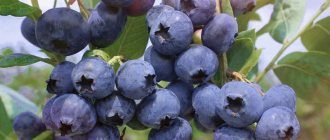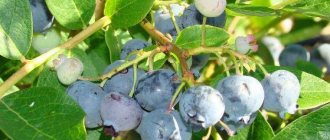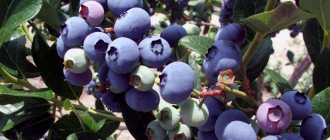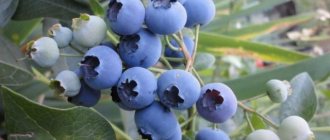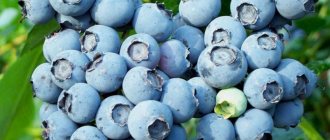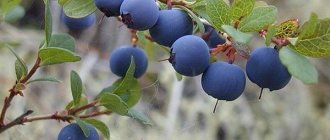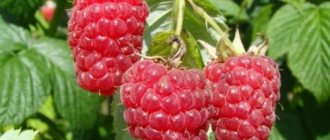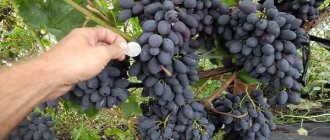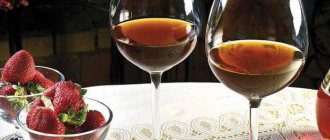Description and features
Bluegold blueberry is a shrub that can reach 1.2 m in height. The plant is frost-resistant and is often found in Central Russia, Siberia and the Urals. The shrub is planted to produce berries or to decorate garden plots. The blueberry tree remains beautiful until late autumn, changing leaf colors from green first to yellow and then to burgundy. In spring, abundant foliage covers many shoots of the plant, then abundant flowering begins, gradually turning into the appearance of many blue berries.
Reviews
- home
- Berry bushes
- BLUEBERRY SEEDLINGS
- Blueberry Bluegold
Tall blueberry Blugold Grows up to 1.2 m in height. At the end of August, the leaves of the bush begin to change color. By the end of September, the bush is covered with burgundy leaves. The taste appears simultaneously with the ripening of the berries. And they color much earlier than ripening. The fruits are easily separated from the stalk and often fall off at the stage of ripeness. The fruits of the Blugold variety are light blue in color and round in shape. The berries are medium in size, 15-18 mm in diameter, weighing up to 2.1 g. The juice has no distinct color. The pulp contains many seeds. The fruits of the Blugold variety have a sweet and sour taste.
According to its characteristics, the Blugold blueberry variety stands out among other varieties of this crop. The winter hardiness and productivity of the variety deserve special attention. Blugold garden blueberries are characterized by average resistance to drought. Watering the bushes is one of the conditions for the crop to bear fruit. The Blugold variety is highly resistant to winter frosts. According to experts, the bushes can withstand temperatures down to -29 ... -35 ° C. Blueberry flowers can tolerate frosts down to -7 ° C.
The garden blueberry variety Blugold has been in cultivation since 1988.
The blueberry bush is spreading, relatively low (1.2-1.5 m), but powerful.
The harvest is very good, regular, 4.5-7 kg per bush.
Blueberries are medium-sized, light blue in color, dense, good taste, with a small scar, can be stored for quite a long time and are easily transported. Suitable for fresh consumption and processing.
The bush has high decorative qualities; the bushes themselves are lush and beautiful, so they will be a wonderful decoration for any garden. However, it is worth considering that spreading is also a disadvantage of this variety of bushes, because they require heavy pruning.
Blugold is an early variety. The fruits acquire a rich color at the beginning of summer and ripen by mid-July. From one bush they harvest from 4.5 kg of berries even in not the most productive years.
Characteristics of the variety
The plant grows quite quickly, with many new shoots appearing in the spring. The appearance of Bluegold blueberries can be described as follows:
- the branches are straight, the crown is shaped like a ball, the bark is brownish in color;
- there are quite a lot of leaves, the length can reach 3.5 cm;
- the root is poorly developed, fibrous;
- The blueberry stalks are small, have a pinkish tint, and there are 7 pieces per brush.
Blugold blueberry is a beautiful plant that is unpretentious to temperature conditions.
Berries
Blugold blueberry fruits are round in shape and light blue in color. The taste is sweet and sour and appears with ripening, but the color is noted much earlier.
The size of the berries reaches 18 mm, weight – approximately 2 grams. The pulp contains many seeds. The berries are separated from the stalks quite easily. When overripe, they can crumble, and when there is a lack of moisture, they dry out and lose their shape.
Flowering period
The Blugold variety begins to bloom in the first half of June. The flowering period is approximately 20 days depending on the surrounding climate.
Blueberries of this type are self-pollinating; both male and female flowers grow on them, so insects and special pollinating varieties are not required.
Ripening time
An average of 7 berries are produced on the clusters, which fully ripen in August. The process occurs gradually, so the harvest can be harvested before the end of the month. The first fruits appear on the bush when it reaches 3-4 years. The best harvest is harvested in the 6th year of the tree’s life.
With good fruiting, you can collect up to 7 kg of berries from a bush.
Areas of application of berries
Blugold blueberries contain many useful vitamins and elements, so it is best to consume them fresh. However, they do not lose their positive properties when frozen or made into jams and preserves.
See also
Description and subtleties of growing Spartan blueberries
Read
Resistance to diseases and pests
The variety has average resistance to pests and various diseases. More often suffers from all kinds of fungi. Cytosporosis, phyllostictous spotting, and septoria are dangerous. Among the pests, the bush is affected by heather arrowhead, leaf roller and moth.
Taste and medicinal properties
Bluegold blueberries have a pleasant taste. Berries contain many organic acids, flavonoids, and phenolic acids. Eating such fruits is beneficial for blood vessels and capillaries. The functioning of the endocrine glands in the body improves, and inflammatory processes decrease. Beneficial substances accelerate the removal of heavy metals from the body.
Beneficial features
It is difficult to overestimate the health benefits of blueberries, because they not only heal, but also help prevent many serious diseases.
Scientists claim that the berries of the miraculous plant strengthen the nervous system, prevent the aging of the body, and improve blood flow and the walls of blood vessels. Regular consumption of fruits has a good effect on vision and memory, and increases concentration. Blueberries will be especially useful for those who have problems with the cardiovascular system, because the berries lower blood pressure and strengthen the arteries. Like most varieties, Blugold is a huge storehouse of vitamins and minerals. By eating several servings of berries a day, you don’t have to worry about buying a vitamin complex, because blueberries contain almost all the elements necessary for the body. In addition, healthy fruits are suitable for people suffering from diabetes and excess weight. Berries will help lower blood sugar and normalize metabolism. And folic acid, which is also found in blueberries, will be a good alternative to pills for expectant mothers.
Gardeners leave very good reviews not only about fresh, but also about frozen blueberries. Of course, having many bushes and a bountiful harvest of several tens of kilograms, it will be simply impossible to eat it fresh.
After many years of studying the beneficial properties of the plant, scientists have found it very useful in treating the nervous system and improving memory. The study involved older people (up to 75 years on average). They ate blueberries every day for twelve weeks. After special tests, improvement in memory and vision was noted.
Participants in this experiment left excellent feedback, they were pleased with the results and noted that blueberries are useful not only for improving memory. It slows down the aging process, protects against heart disease, and in some cases helps against cancer.
At the same time, these are inconclusive studies. It is believed that blueberries can relax the walls of blood vessels, which can reduce the risk of atherosclerosis by strengthening the arteries. Atherosclerosis increases the risk of heart attack.
A small study conducted in 2015 recruited 48 postmenopausal women. They were given berries for eight weeks. At the end of the experiment, a decrease in blood pressure was noticed.
Numerous studies have proven that including blueberries in your diet reduces the risk of obesity, diabetes, and improves complexion. People feel energetic, full of strength and health.
To enjoy blueberries throughout the year, you can freeze them in the refrigerator. The berry perfectly retains all its beneficial properties when frozen. It is stored at a temperature of 0 ̊ -17 ̊ C, or even lower than these figures. Over the course of six months, researchers did not detect a decrease in valuable substances in the berry.
For blueberries to benefit you, it is recommended that you eat about three servings (that's about three cups) throughout the day. It's amazing how many berries fit in one cup. There are about 100-150 pieces in 1-2 g of this valuable product! Considering the wide variety of nutrients found in blueberries, they are recommended to be consumed for the “defense capacity” of our body.
Advantages and disadvantages of the variety
The Blugold variety has many advantages over other similar berries:
- long-term storage possible;
- dense berry pulp;
- large volume of harvest;
- self-pollinating variety;
- resistance to low temperatures.
However, this variety also has several disadvantages, although not too significant:
- in the heat, the berries dry out quickly;
- when overripe, the fruits fall off;
- The bush grows very quickly.
How to plant correctly
To get a good harvest, you should plant the plant correctly. Care in the future is also important.
Recommendations for choosing deadlines
It is best to plant young bushes in the spring. During the warm season, the plant will take root well and begin to grow branches and roots. If the region is warm, then autumn planting is allowed.
Requirements for location and soil
Blugold blueberry bushes are planted in areas with good lighting, protected from the wind.
For planting, choose flat or elevated areas; this type of berry does not like heavily moist soil.
Site selection and preparation
It is better if the soil is acidic. For planting, a special mixture is prepared - high-moor peat, pine needles, sawdust and sand are mixed. If the soil on the site is heavy and clayey, it is recommended to install a drainage layer.
How to select and prepare planting material
It is recommended to purchase real and good seedlings from nurseries. Before purchasing, you should carefully inspect the plant for damage and various diseases. If the root system is open, then before planting the seedling should be placed in water for a couple of hours. Plants with closed roots are watered before transplanting.
Planting scheme
Before planting a seedling, a hole is dug in a designated area to a depth of half a meter, with a diameter of approximately 60 cm. Crushed stone and a prepared soil mixture are poured into the bottom of the hole. After planting, the plant is well watered and mulched. The distance between bushes should not be less than 1 meter.
Recommendations for planting
Blugold, like any other blueberry, is not least valued by gardeners for its unpretentiousness and ease of care. This is not surprising, because in nature it is found mainly in northern countries - Canada, Sweden, Norway, Iceland, where the climate is not mild.
Landing procedure and preparation for it
Choosing the right site for growing Bluegold blueberries is the key to a bountiful harvest in the future. She needs a place well warmed by the sun. A lack of light and heat negatively affects the taste of the berries; they become noticeably sour and the skin becomes coarser. It is advisable that groundwater does not approach the surface closer than 50–60 cm, otherwise it will be necessary to build an embankment 15–20 cm high.
The area should be protected from cold drafts, but, nevertheless, it is important to provide the possibility of ventilation. Otherwise, the bushes will suffer from pathogenic fungi.
It is advisable that at some distance from the blueberry bushes there is a natural or artificial barrier that protects from the wind
Blueberries prefer acidic soil (pH 3.5–4.5). The Blugold variety is less demanding on soil acidity; the optimal pH for it is 5.0–5.5. Therefore, the acid-base balance of the soil must be determined in advance. If it does not meet the required parameters, fresh manure, pine sawdust, pine needles, peat chips, colloidal sulfur are added to the soil, or the area designated for blueberries is spilled with acetic or citric acid. In this case, the substrate should be light enough and allow air to pass through well. Blueberries will not grow in heavy soils.
Acetic acid is one of the most common soil acidification agents.
The root system of Blugold blueberries is superficial, so the average depth of the planting hole is 35–40 cm, the diameter is about 0.5 m. When planting several plants at the same time, maintain a distance between them approximately equal to the height of an adult bush.
Blueberries have a superficial root system, so they do not need a deep planting hole.
At the bottom, a layer of drainage about 5 cm thick is required (brick chips, expanded clay, pebbles, clay shards). Then a mixture of high-moor peat, pine sawdust, and coarse river sand is poured into the pit. All ingredients are taken in approximately equal proportions. Fertilizers include Nitroammofoska, Diammofoska, Azofoska (25–40 g).
Nitroammofoska is a complex fertilizer, a source of all elements necessary for blueberries.
The so-called mycorrhiza must be added to the planting pit for blueberries. This is a community of plants and special fungi specific to all plants from the Ericaceae family. Mycorrhiza is vital for the proper development of the plant. If the seedling was purchased from a special nursery, it is already present in the top layer of soil. It must be preserved, just like the water in which the plant was soaked (it is used to water a newly planted bush).
Mycorrhiza is a kind of “fringe” at the tips of the roots of plants belonging to the Heather family.
Also, mycorrhiza in the form of a dry concentrate can be purchased in specialized stores, but there it is relatively rare. Another way is to find a place in the forest where blueberries, lingonberries, and cranberries grow, cut off some turf along with the roots, chop it and add it to the planting hole.
The soil under blueberries is a natural source of mycorrhiza
Video: preparing the soil for planting blueberries
Landing dates
The best time to plant blueberries is spring. You need to be in time before the leaves begin to bloom. Autumn is not very suitable because the weather in most of Russia is unpredictable. You need to be sure that there are at least two months left before the first frost. Only in this case will the bush have time to adapt to new living conditions and will not die in winter.
Selection of seedlings
The best option is a 1-year-old or 2-year-old seedling. They best tolerate the stress associated with transplantation. Bushes are purchased from specialized stores or trustworthy nurseries.
It is desirable that they be located in the same area as the site, or to the north.
High-quality planting material can only be purchased from reliable suppliers
Planting blueberries
The landing procedure has the following features:
- Blueberry seedlings are usually sold in small containers. 0.5 hours before planting, they need to be soaked together with the container in water, a pale pink solution of potassium permanganate or a solution of any biostimulant (potassium humate, succinic acid, Epin), prepared according to the instructions.
- The root system of blueberries is fibrous, the roots quickly become tangled. Before planting, the lower 2–3 mm of the “pile” is cut off with a sharp, clean knife. They also make 5-6 longitudinal cuts 1.5-2 cm deep, their edges are “fluffed”.
- The roots need to be placed closer to the surface, at a maximum depth of 6–8 cm. They are covered with the same mixture that was at the bottom of the planting hole. The soil is not compacted to ensure free access of air.
- Blueberries do not have a root collar, so there is no need to monitor its position. Gardeners' advice is to deepen the bases of the shoots into the soil by 3–5 cm. Then the bush begins to branch much more intensely.
- The seedling is watered abundantly, using at least 10 liters of water. Then the tree trunk circle is mulched, creating a layer at least 5 cm thick. This will significantly save time on weeding. The best material is chips or small pieces of coniferous tree bark, sphagnum moss. You can use any covering material, white or black. But peat is absolutely not suitable - weeds quickly grow through it, it does not absorb water well, diverting it from the bush.
After planting, the blueberry bush is watered and mulched.
Video: how to plant a blueberry bush correctly
Rules of care
Proper care will allow the plant to develop well and bear fruit better, so it is recommended to follow the necessary rules.
Watering mode
The plant does not like stagnant moisture, but moderate watering is necessary. The top layer of soil to a depth of 15-20 cm should always be moistened.
In rainy summers, you can refuse watering; in dry summers, once every 2-3 days will be enough. It is better to carry out the procedure in the evening using the sprinkling method.
It is better not to pour water under the roots so that they do not become bare and dry out.
Mulching
For mulching, it is permissible to use peat, sawdust or pine needles. It is recommended to carry out the procedure in the autumn to prevent the roots from freezing in winter. In spring, mulch is laid to maintain the necessary soil moisture.
See also
Growing and planting cloudberries in the garden, care rules for open ground
Read
Top dressing
Timely fertilizing will allow you to get a good harvest. For this purpose, ammonium sulfate, potassium sulfate, ammonium nitrate, and superphosphate are chosen. It is not allowed to use ash, compost and potassium chloride.
Trimming
It is recommended to periodically trim the crown of blueberry bushes. After wintering, the frozen branches are removed, and in the autumn they give the tree its shape, removing the excess.
Preparing for winter
The Blugold variety tolerates low temperatures well, so it does not require careful shelter in the winter. Young trees can be covered with film, throwing it over the arches. If there is enough snow in winter, then it is permissible to throw it at the plant to create a snowdrift.
Before wintering, the plant is fed with Calimagnesia and the root system is covered with mulch.
Weeding
Frequent loosening and weeding provide good oxygen access to the root system and help get rid of various weeds.
Diseases and pests
Blueberries are often affected by fungal diseases and harmful insects. These problems must be dealt with in order to prevent the death of the plant.
Mummification of fruits
The disease is characterized by drying out of branches and the formation of a gray mass. Subsequently, the berries begin to dry out and acquire an orange-brown tint. To prevent further development of the disease, spoiled fruits and branches are removed and sprayed with special preparations. Bordeaux mixture or Topsin solution are best suited.
spotting
The disease is characterized by wilting and falling of leaves, and the appearance of red spots on them. The plant is sprayed with Bordeaux mixture or Rovral (a solution is prepared). The disease can be avoided by following the rules of watering, mulching the soil and preventive treatment with special preparations.
Fruit moth
This butterfly can cause quite serious damage to the bush. Caterpillars eat leaves, buds and even blueberries. To get rid of the pest, you need to treat the bushes with Lepidocide several times every 10 days.
Gallica
When plants are affected by such a pest, eggs may be found on the back of the leaves. You can get rid of it by removing damaged branches and treating them with Fufanon.
Prevention of plant damage by pests includes spraying with special pest repellents and removing diseased and damaged branches.
Note to housewives
Blueberries can be prepared for the winter in any way. If you decide to dry, you need to sort out the berries, wash them, and let them drain. Then pour them into a sieve and place on a baking sheet, which we place in the oven with the door open. Turn on the oven at low temperature. Shake the berries periodically so that they dry evenly. Drying can be stored in a linen bag. To use, just soak the berries in warm water. In the future, they can be used to fill a pie, compote or to prepare a fruit smoothie. Enjoy your meal.
Harvest and storage
Blueberries should be harvested when the berries easily come away from the stalk. You can’t wait long - the fruits may crumble or dry out. Collected from top to bottom of the tree.
You can store blueberries for up to 15 days in containers lined with cloth or paper. Fruits can remain unchanged in the refrigerator for up to six months. You can make puree from them with the addition of granulated sugar.
